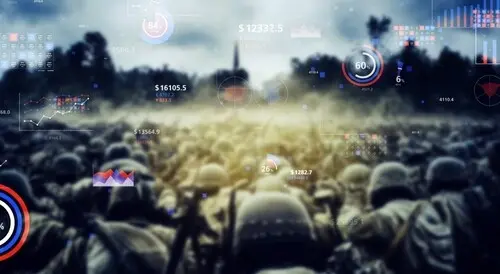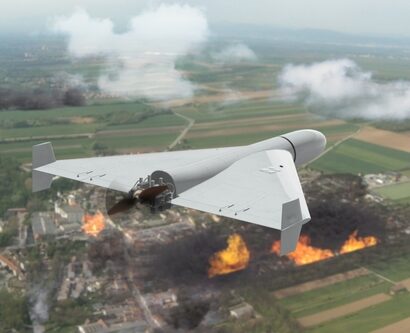Abstract: As a prerequisite to effectively identifying and countering cyber and hybrid threats, as well as cognitive warfare/superiority campaigns against Western democracies worldwide, it is crucial to have cross-governmental and international information-sharing capabilities. Due to the vast amount of data, this process must be supported by technically advanced AI/ML-powered technology to analyse multilingual and publicly available information in near real-time. Such monitoring systems must send timely alerts to specific decision-makers, supporting them in formulating appropriate responses to hybrid activities as part of emerging and evolving cognitive warfare campaigns from adversarial countries like Russia and/or the People’s Republic of China.
Problem statement: How will cyber threats based on new / disrupting cyber-related technologies evolve?
So what?: Cyber-attacks exploiting vulnerabilities in artificial intelligence (AI) models are of particular concern in critical areas such as medicine, financial systems, and national defense, where AI-based decisions have important consequences. NATO and the EU must do everything to prepare our societies to promote a mindset that encourages questioning the integrity of information in principle, being more suspicious against signs of manipulation, minimising internal isolation, embracing the necessity of reporting suspicious behaviour, and fostering proactive calls for support within the wider community whenever necessary. Therefore, A stronger and more robust security culture is needed.

Source: shutterstock.com/metamorworks
The Intersection of AI and Cybersecurity
The Russian attack on Ukraine is already in its third year. However, the war itself had been prepared long before in cyberspace and started well before any physical activity through cyber-attacks. Moreover, even the first physical strike in February 2022 was prepared in cyberspace: Within the first minutes of the military attack on Ukraine, Russia paralysed the KA-Sat satellite network. However, this attack had unintended consequences, disrupting many internet services in Europe.[1] In Germany, for example, 5,800 Enercon wind turbines were affected. In France, almost 9,000 subscribers to a satellite internet service also experienced outages. Other countries affected included Italy, Poland, Hungary and Greece.[2] Parallel to its activities in and around Ukraine, Russia has carried out an intensive campaign of hybrid warfare against Western societies to advance a couple of different strategic objectives, like isolating Ukraine, cracking Western support, and, unfortunately, being successful in gaining new allies in Africa and Asia. Russia’s disinformation campaigns in Africa were successful in several countries, including Cameroon, Central African Republic (CAR), Côte d’Ivoire, the Democratic Republic of the Congo (DRC), Libya, Madagascar, Mozambique and Sudan. In Asia, Russia has influenced countries such as India, Indonesia, the Philippines, Malaysia, Japan, and South Korea. These campaigns often aim to promote pro-Russian narratives and undermine Western influence. The efforts typically focus on spreading misinformation to influence public opinion and political processes.[3]
Within the first minutes of the military attack on Ukraine, Russia paralysed the KA-Sat satellite network.
The means chosen included the destabilisation of Western democracies through the spread of conspiracy theories on the Internet and direct interference in Western elections,[4] attacks on ammunition depots in Bulgaria and the Czech Republic,[5] the murder of Russian regime opponents in Europe,[6] and massive cyber-attacks on critical infrastructure and public institutions. Russia has, for example, promoted numerous conspiracy theories around elections, particularly in the U.S. These include false claims about widespread voter fraud, the vulnerability of mail-in ballots, and the manipulation of voting machines.[7] However, also during the pandemic, Russia spread conspiracy theories about the origins of COVID-19, the safety and efficiency of vaccines, and the intentions behind public health measures. These theories aimed to sow distrust in governments and health authorities. Another common theme is the accusation that Western countries stage false flag operations to justify military interventions or political actions. These theories claim that events like terrorist attacks or chemical weapon use are orchestrated by Western governments to manipulate public opinion.[8]
Russia also often promotes conspiracy theories that paint Western countries, especially the U.S., as corrupt and manipulative. These narratives suggest that Western governments are involved in secret plots to control global politics and economics.[9] The conspiracy theories are disseminated through various channels, including state-controlled media, social media platforms, and sympathetic influencers. The goal is often to create confusion, undermine trust in institutions, and destabilise societies.
When the Russian attack began in February 2022, Western democracies were shocked. Although tough measures such as economic sanctions were threatened in advance, Russia was not deterred and attacked Ukraine on a broad front. In the beginning, Ukrainian and Russian diplomats also met to negotiate a ceasefire. After more than 2.5 years of war, however, a peace agreement seems a long way off. The West, still supporting Ukraine, and Russia have firmly positioned themselves as adversaries, a reality that will continue to persist, even if the guns in Ukraine fall silent. Cyberspace has blurred the lines between peace and war, making a new cold war undeniable.
When the Russian attack began in February 2022, Western democracies were shocked.
In 2024, the cybersecurity landscape is more dynamic and challenging than ever. As cyber threats evolve, traditional defence approaches struggle to keep pace. AI-driven systems offer promising solutions. The need for reliable information and the sustainability of mainstream media that presents diverse political Perspectives is critically important in (2024) a year marked by pivotal elections in more than 40 democracies worldwide while wars continue to rage in Europe and the Middle East. Improving media literacy and fostering a more resilient society are key challenges. The same technology, which can be used to manipulate the infosphere, is also able to be leveraged for fact-checking, disinformation tracking, integrity and authenticity checking, credibility scoring, malicious spam/bot detection and blocking, and secure coding.
Hybrid Threats and AI – the Dark Twins
Hybrid threats combine conventional military tactics, cyberattacks, disinformation campaigns, and other non-traditional methods. These tactics blur the lines between state and non-state actors, internal and external, peace and war while trying to stay below the certain recognisable threshold, thus making attribution challenging:[10]
The use of AI amplifies hybrid threats
- More sophisticated cyberattacks: AI can automate and optimise existing processes and, therefore, also those which are used with a malign intent: cyberattacks become more and more potent. For example, AI-generated phishing emails can be better tailored to specific targets, increasing their persuasiveness and leading to more successful attacks. State or non-state actors might use AI to create false attribution trails and tracks, hiding the true source of an attack. AI can enable proxy attacks, where an actor uses AI tools to carry out an operation without direct personal involvement through (even artificial) proxies.[11]
- Disinformation campaigns: AI can create and amplify the dissemination of fake news, deepfakes, and manipulated content. As a consequence, trust in online information erodes and exacerbates hybrid threats many times over. AI-generated deepfake videos spread false narratives, manipulate public opinion, and undermine trust in existing information sources. AI algorithms amplify disinformation on social platforms, sowing discord and confusion.[12]
- The physical weaponisation of AI: AI can be used to automate cyberattacks, making them more efficient and widespread and can be used by terrorist groups or rogue actors to plan biological or chemical attacks. AI-driven malware enables rapidly propagating across networks, causing significant damage even on physical network elements. AI-powered drones or autonomous weapons carry out highly precise strikes, bypassing traditional defences and escalating conflicts.[13]
In conclusion, AI’s impact on hybrid threats is multifaceted. It introduces new and more dangerous risks.
Hybrid threats in the cognitive domain
Cognitive superiority[14] can be seen as one of the decisive goals of modern information, cyber and hybrid warfare, relying on access to information, pervasive surveillance, personalised persuasion, and new technologies. While the concept of cognitive superiority is nothing new, its importance within the military domain– traditionally the primary carrier of defence –needs more systematic assessment, especially regarding its broader societal impact. Therefore, hybrid threats’ broad field and impact must be viewed in a more differentiated and sophisticated way and manner.[15]
Cognitive warfare–a relatively modern term in the field of hybrid threats–refers to a more holistic approach to cognitive superiority. Main goals of cognitive warfare are attacking societal leadership, influencing the perceptions of local communities as well as entire societies to disrupt or fragment societies and make them even more vulnerable or receptive to manipulation. Like other hybrid warfare tactics and techniques, cognitive warfare has, except for targeted killings, no kinetic component. Still, it could have direct physical consequences (e.g. through radicalisation) but usually stays below the threshold of open conflict(s).
Here, cyberspace has developed a Janus-faced nature. In addition to its advantages in fostering democracies through more transparency and participation, it has started also to facilitate the creation of a vitreous human and–potentially–transparent society.
Cyberspace has developed a Janus-faced nature.
The widespread use of digitalisation made the virtual cyberspace a place for “real meetings”, a diplomatic tool, an economic factor, a military effector, and last but not least: a social space, satisfying especially human needs for connectivity. On the one hand, cyberspace has democratised access to information as an unlimited, borderless and barrier-free space. On the other hand, however, it has “damaged” the Westphalian paradigm of the state as guardian of sovereignty almost to the point of its dissolution. By overriding the state’s monopoly of (physical) power, cyberspace has introduced new and different forms of power and even violence. Malign actors have direct access to influence almost every target audience, allowing them to set, undermine, or dominate intra-societal narratives.[16]
One of the biggest “hybrid” threats is malign actors’ activities to destabilise the foundations of the “Western” value-based cognitive domain by undermining core values, such as human dignity, freedom, democracy, equality, the rule of law and adherence to human rights are critical. Especially the “cognitive” battle for narratives in cyberspace, which is a reality. This battle seeks to dominate the cognitive domain and gain advantages by controlling the narratives. Currently, one of the most damaging impacts on society is the pervasive penetration of social media, which erodes empathy[17] and undermines existing elements of societal resilience from within.
The impact of new Technologies
One of the key issues of recent years that will keep the (Western) world busy for a long time to come is new technologies, in particular AI and Cloud computing. This development is being driven by the increase in existing data volumes and the use of this data. However, what often receives a lot of attention in exemplary projects does not necessarily correspond to reality.
Data has long been seen as the new gold: the Big Five of the technology industry, also known by the abbreviation FAANG (Facebook, Amazon, Apple, Netflix, Google), generated a market capitalisation of nearly 4 trillion dollars in 2023 to large extent from the use of information only.[18] Together with Microsoft’s 7 trillion dollar turnaround, the market capitalisation of information can be valued up to 11 trillion dollars, accounting for almost 25% of the U.S. stock market’s total market capitalisation of $31 trillion.
The Big Five of the technology industry generated a market capitalisation of nearly 4 trillion dollars in 2023 to large extent from the use of information only.
New technologies are, therefore, obviously fundamentally changing the economy and society. They drive entrepreneurial innovation, productivity, and regional economic growth. They also affect growth, labour markets, and political participation. The consequence places new demands on education and training–not just in the area of information and communication technologies but also in literacy.
The ability to adapt to the changing world through the education and training system is of fundamental importance, especially from an educational societal perspective. In the future, the question of how fast and deep new technologies will penetrate (Western) societies and how they will change productivity, employment and competitiveness in different countries must be of central interest.
Example: The growth of data-amount[19]
1 Zettabyte (ZB) = 1 000 000 000 000 000 000 000 byte
1 zettabyte is equal to 1,000 exabytes or 1 billion terabytes.
Amount of digital data generated annually worldwide (in ZB, forecast for 2025):
- 2015: 15,5
- 2018: 33
- 2023: 121
- 2025: 181

Source: Author.
Technics needed, to deal with…
Quantum Computing
Quantum Computing expands the existing limits of conventional computing with their binary states of 1 or 0. Adding more states, the computing power increases significantly. Quantum researchers are implementing this idea using quantum physics to create and use quantum bits, also called “qubits”.
Qubits can represent superpositions of the states 0 and 1 as well as various intermediate levels. Thanks to these inherent properties, quantum computers are very powerful in theory. Currently, they still struggle with a high error rate. Once this problem is solved, quantum computers may even be able to crack cryptographic codes.[20]
Cloud and Edge Computing
Cloud computing forms the foundation for many future innovations in different technologies and applications:[21]
- Serverless IT architecture: In the future, companies and also governments will no longer need servers but will use a cloud infrastructure that they can scale at will.
- Artificial intelligence: AI requires huge amounts of data (big data), which are mostly available in unstructured form. In the future, these will be stored in the cloud and retrieved from there so that only the results need to be sent to the end devices.
- Smart city: In the city of the future, automobiles, buses and trains will drive autonomously, buildings will optimise their infrastructure independently and digitisation will make it easier to save energy. The corresponding data is stored in the cloud.
- Agriculture: Automation and precision farming promises more sustainable and, at the same time, more cost-efficient cultivation of the soil. To do this, the producers involved exchange information about cloud tools and share data on the germination rate.
Edge computing, as an extension of cloud computing, allows a shared approach between the cloud and the client. By mediating data processing between the device and the cloud, only the results of calculations have to be transmitted to the cloud. Thus, it reduces the latency of intelligent devices, leading to faster reaction times. Edge computing forms the basis for the Internet of Things (IoT) and Computing.[22]
Risk mitigation to maintain cognitive superiority (or mental health)
The war in Ukraine gives the impression of a return to the Cold War. A new political agenda has been created in North America and Europe that pits democracies against autocracies. However, the war in Ukraine has too many dimensions to be reduced to a simple conflict between democracy and autocracy. Such a simplification ignores the different levels and qualities of Western and European democracies. The lack of a democratic political system in Russia or China has not prevented North America or the European Union from entering into economic cooperation and increasing investment in and trade with these countries. A blatant example of this is the construction of the Nord Stream pipeline, which was supported primarily by Germany. Presenting support for Ukraine as a defence of democracy is a simplification designed to generate global support. In fact, it obscures the problem and conceals the fact that all European countries continued to do business with Russia even after Moscow annexed Crimea in 2014. It is, therefore, problematic to view the war in Ukraine from this binary political perspective of democracy and autocracy when it should actually be about the defence and inviolability of the borders between states.[23]
A new political agenda has been created in North America and Europe that pits democracies against autocracies.
An inviolability that has never existed and will never exist in cyberspace. In cyberspace, since its inception, those who were ahead in the technology field have always had the advantage, but what is now even more important is the cognitive superiority that can be achieved in cyber and information space.
Both sides use targeted disinformation and propaganda to influence public opinion and weaken the enemy’s morale. This includes the spread of fake news, the manipulation of social media, and the use of mass media to spread enemy images. Russia also uses historical narratives to underpin political goals. This instrumentalisation of history strengthens the identity and cohesion of its own population and underpins the legitimacy of its own position.
Under Vladimir Putin, for example, a historical narrative has developed in the Russian Federation that combines the ideology of the “Russian World”. In short, an uncritical attitude towards the Russian Empire and a nostalgic glorification of the Soviet era, including the justification of Stalin’s totalitarianism. The extreme cult of the “Great Patriotic War” is central to this narrative. It also served to convince the Russian population that the Soviet Union was a victim of the Second World War and that, for example, Finland was the first to attack it in the autumn of 1939, and that the Hitler-Stalin Pact is a myth of European historiography. In reality, World War II began exactly after the Hitler-Stalin Pact, in which both powers agreed to divide and occupy Poland, and it ended with participation in the war against Japan to conquer further territories. Reinforced by Putin’s deception is, among other things, that the Russian population ultimately believes in Russia’s invincibility.
Resume
In 2024, the cybersecurity landscape is more dynamic and challenging than ever. As cyber threats become more sophisticated and frequent, countries must prioritise robust security measures to protect their sensitive data and maintain operational integrity. Technological advances are changing the way nations approach cybersecurity, offering innovative tools and methods to stay one step ahead of malicious actors. It is critical for us to understand these changes to protect societies and ensure resilience in an increasingly connected world. The tools available for cybersecurity are evolving rapidly, from the integration of artificial intelligence (AI) and machine learning (ML) to the promising developments in quantum computing and blockchain technology. These advances are not only improving the ability to detect and respond to threats but are also introducing new paradigms and advanced cloud security solutions. These changes must be taken seriously and lead to proactively implementing advanced security measures that protect our democracies and keep us ahead in an increasingly digital world. The future of cybersecurity is here, and it is more powerful and dynamic than ever before.
Technological advances are changing the way nations approach cybersecurity, offering innovative tools and methods to stay one step ahead of malicious actors.
It means that societal and political security are now two sides of the same coin. To destabilise democratic states, new technologies as a hybrid threat can be used in cyber operations, information warfare, cyber-enabled disinformation operations, foreign direct investment, as well as in social media to manipulate large numbers of people. Designing technology-driven, human-centred, community-driven accessible solutions for society as a whole is a significant step towards building deeper media literacy, fostering resilience and instilling a stronger security culture. These allow citizens to participate more easily in querying the integrity of information, identify signs of manipulation, minimise isolation, learn the importance of reporting suspicious behaviour, and ask for help within the wider community whenever necessary.
Colonel Josef Schroefl started his career in the Austrian Armed Forces in 1982 and worked since then in various areas of the military, including several military operations/UN tours, e.g. to Syria. He holds a B.A. in Computer Technology and an M.A. in Intern. Relations from the University of Delaware/U.S. and a PhD in International Politics from the University of Vienna. Several publications/books on Asymmetric/Cyber/Hybrid threats, crisis, conflict and warfare. Current position: Deputy Director for CoI Strategy & Defense at the hybrid CoE in Helsinki/Finland, leading the Cyber-Workstrand.
Colonel Sönke Marahrens is a career Air Force officer, previously serving as head of research for Strategy and Armed Forces at the German Institute for Defence and Strategic Studies in Hamburg. He also has a full diploma in computer science, and he holds a master’s degree from the Royal Military College in Kingston, Canada, and another from the University of the Federal Armed Forces in Hamburg. He was deployed with NATO to Bosnia and Kosovo, and in 2020, he served as branch head for transition at HQ Resolute Support in Kabul, Afghanistan.
The views contained in this article are the authors’ alone and do not represent the views of the Austrian MoD, the German MoD, or the Hybrid CoE.
[1] Viasat is providing an overview and incident report on the cyber-attack against the KA-SAT network, which occurred on February 24, 2022, and resulted in a partial interruption of KA-SAT’s consumer-oriented satellite broadband service. https://news.viasat.com/blog/corporate/ka-sat-network-cyber-attack-overview.
[2] One of the cases described at the cyberconflict platform. https://cyberconflicts.cyberpeaceinstitute.org/law-and-policy/cases/viasat
[3] An exemplary list of countries affected in Africa can be found on: https://africacenter.org/spotlight/russian-disinformation-campaigns-target-africa-interview-shelby-grossman/; the influence of Russia to African and Asian countries are described in the BBC report from February 2023: https://www.bbc.com/news/world-africa-64451376.
[4] John Irish, “European election: How the EU says Russia is spreading disinformation,” June 03, 2024, https://www.reuters.com/world/europe/european-election-how-eu-says-russia-is-spreading-disinformation-2024-06-03/.
[5] The Bellingcat Investigation Team of volunteers and full-time investigators who make up the core of the Bellingcat’s investigative efforts. https://www.bellingcat.com/news/uk-and-europe/2021/04/26/how-gru-sabotage-and-assassination-operations-in-czechia-and-bulgaria-sought-to-undermine-ukraine/.
[6] Steve Gutterman, “The List Is Long: Russians Who Have Died After Running Afoul Of The Kremlin,” in: Radio Free Europe, February 16, 2024, https://www.rferl.org/a/enemies-kremlin-deaths-prigozhin-list/32562583.html.
[7] That example has also been described within the U.S. by the online-newspaper “Michiganadvance”: https://michiganadvance.com/2024/10/25/firehose-of-election-conspiracy-theories-floods-final-days-of-the-campaign/
[8] Five Russian disinformation tactics have been excellently characterised in the online-journal “The Conversation”: https://theconversation.com/five-disinformation-tactics-russia-is-using-to-try-to-influence-the-us-election-238379
[9] As described in the BBC-report: https://www.bbc.com/news/world-europe-64789737
[10] Common publication about Hybrid threats from Hybrid CoE, September 2023, https://www.hybridcoe.fi/hybrid-threats-as-a-phenomenon/.
[11] Thomas H. Davenport, Matthias Holweg, and Dan Jeavons, “How AI Is Helping Companies Redesign Processes,” March 02, 2023, https://hbr.org/2023/03/how-ai-is-helping-companies-redesign-processes.
[12] Dennis Hillemann, “AI Misinformation Threatens 2024 US Elections,” Medium, January 06, 2024, https://dhillemann.medium.com/ai-misinformation-threatens-2024-us-elections-72a3e804b383.
[13] Derived from a U.S.-Department of Homeland Security Report on Reducing the Risks at the Intersection of Artificial Intelligence and Chemical, Biological, Radiological, and Nuclear Threats from April 26, 2024, https://www.dhs.gov/sites/default/files/2024-06/24_0620_cwmd-dhs-cbrn-ai-eo-report-04262024-public-release.pdf.
[14] Even after three years of sharing one office, both authors still disagree on the notion of cognitive superiority: whereas Josef believes in it, Sönke still denies its existence – even vast amounts of Finnish coffee could not heal this.
[15] Outcome of the Cyber/Hybrid-Symposium took place on October 10, 2023 with the title “The relationship between hybrid warfare and cognitive threats studied from the cyber defence point of view,” Hybrid CoE, https://www.hybridcoe.fi/news/the-relationship-between-hybrid-warfare-and-cognitive-threats-studied-from-the-cyber-defence-point-of-view/.
[16] Matthias Wasinger, “The Highest Form of Freedom and the West’s Best Weapon to Counter Cognitive Warfare,” May 20, 2024, The Defence Horizon Journal, https://tdhj.org/blog/post/freedom-counter-cognitive-warfare/.
[17] Bernard Claverie and François du Cluzel, “The Cognitive Warfare Concept,” December 2023, https://innovationhub-act.org/wp-content/uploads/2023/12/CW-article-Claverie-du-Cluzel-final_0.pdf.
[18] The Corporate Finance Institute (CFI) is one of the leading global providers of training and productivity tools for finance and banking professionals. The Information is free and available on their homepage: https://corporatefinanceinstitute.com/resources/equities/faang-stocks/.
[19] Statista is a global data and business intelligence platform with an extensive collection of statistics, reports, and insights on over 80,000 topics from 22,500 sources in 170 industries. Established in Germany in 2007, Statista operates in 13 locations worldwide and employs around 1,100 professionals. The figures used are from the following source: https://www.statista.com/statistics/871513/worldwide-data-created/.
[20] This definition was taken verbatim from the article from Matt Swayne, “What is Quantum Computing? [Everything You Need to Know],” February 02, 2024, The Quantum Insider, https://thequantuminsider.com/2024/02/02/what-is-quantum-computing.
[21] Rafia Islam, Vardhan Patamsetti, Aparna Gadhi, Ragha Madhavi Gondu, Chinna Manikanta Bandaru, Sai Chaitanya Kesani, Olatunde Abiona, “The Future of Cloud Computing: Benefits and Challenges,” in: International Journal of Communications, Network and System Sciences, Vol.16 No.4, April 2023, https://www.scirp.org/journal/paperinformation?paperid=124299.
[22] Idem.
[23] Ummu Salma Bava, “Democracies versus autocracies – this is not the new global conflict line,” in: DER STANDARD Intl., June 18, 2023.




